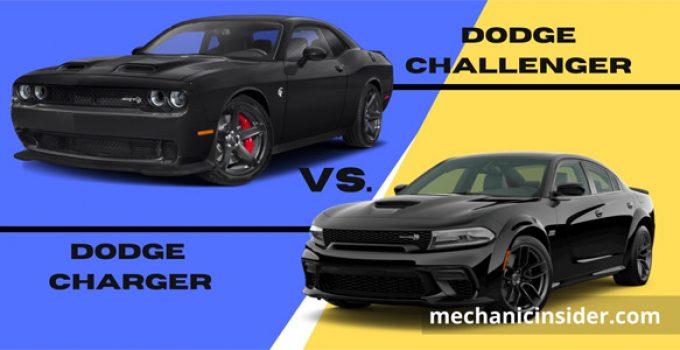If you are a muscle car enthusiast, you are, of course, aware of the dilemma between Dodge Challenger and Dodge charger. They were both born and bred in the muscle car era of the 1900s. They have both been around for decades, and nobody can deny their influence on the muscle car industry.
With the incredible V8 engine and retro-styled touches, the modern Challenger and Charger appeal to all car enthusiasts. And if you make a list for affordable muscle cars, these two would probably be on the top. Here comes the echoing question in the muscle car industry. Dodge Challenger Vs. Charger, who comes out on top? That is where we come in. So, keep reading this article to see who emerges victorious!
Dodge Challenger vs. Charger
Go through these comparisons, you'll surely meet your queries.
Exterior
The exterior is the first thing that comes to mind when you take a look at both cars. You can tell that both these beasts are different from each other by looking at them. Let us take a look at the Dodge Challenger.
The new Challenger sports a set of a spherical projector-beam couple with a group of 18-inch Satin Carbon Aluminum Wheels. The spherical headlamps can help your Challenger to be seen and see.
The two-door challenger comes equipped with a wide wheelbase. It gives the driver plenty of wiggle room and helps you stand out on the road. With an overall height of 575 inches, you can easily call the 2-door Challenger a masterpiece.
But make no mistake, the Dodge Charger is not falling behind its cousin.
The stunning four-door Sedan can capture your attention with its LED ultra-bright Daytime-running lights. The four-doored Sedan sports solar control glass and 17-inch wheels. That is not all. The four-door Charger features dual bright exhaust tips, fuel-filler doors, and rear heated glass. With an overall height of 58.5 inches, the Dodge Charger is magnificent as well.
Interior
The apparent difference between the Dodge Challenger and Charger is the number of doors.
Even though both of them take after the 90s-Mercedes-Benz-derived platform, the Challenger is a four-door Sedan. Whereas the Charger is a two-door Coupe. In terms of the interior, the Dodge Charger houses more space than the Challenger.
But that does not mean that the Challenger is cramped. Let us take a look at the factual data.
The Dodge Charger comes equipped with a standard passenger volume of 93.7 cubic feet. On the other hand, the Dodge Challenger has a passenger-housing space of 104.7 cubic feet.
Do note that while the Challenger has a more spacious interior, the Charger has an easily accessible passenger seat. Although some say that the Charger is more reliable when it comes to the interior, there are no apparent reasons.
Performance
When you roll through the powertrain lineups, a noticeable pattern displays that the Challenger has a little more power than the Charger. You can even say that Dodge has made the Challenger more powerful.
What appeals to most people about the Charger is the four-doors combination with high-powered engines. The Charger comes equipped with a horsepower of 295 HP.
On the other hand, the Dodge Challenger has a horsepower of 305 HP. The Challenger holds a little victory over the Charger when it comes to speed. The difference between their rate and power output is almost negligible.
Both the mechanical beasts come standard with a V6 engine with 3.6L. When equipped with the same engine, the Challenger wins by a margin in terms of torque output.
The Dodge Challenger 4 door generates a torque of 268 lb-ft. Whereas the Dodge Charger generates a torque of 264 lb-ft. So, if you are looking for performance, the Dodge Challenger has the advantage. Between the Dodge Challenger versus Charger, the Challenger wins, at least on paper.
Engines
Both the Challenger and the Charger have a wide variety of engines available over the past decade. Do note that we will be focusing on the models from 2015 to 2020. We will be doing so to make a simplified list rather than a bewildering one.
Before we begin, note that most of the versions of the Challenger come equipped with rear-wheel drive. The eight-speed automatic is standard as well. However, you can opt for the manual transmission when using V8 engines.
V6 engine with 3.6L (Standard with 268 lb-ft torque and 305 horsepower)
V8 engine with 5.7L (Automatic transmission offers 395 lb-ft torque and 370 horsepower, flexible cam and manual transmission offers 410 lb-ft torque and 375 horsepower)
V8 engine with 6.4L (475 lb-ft torque and 485 horsepower)
On the other hand, the Charger engine comes only with automatic transmission. Most versions come equipped with rear-wheel drive. However, V6 powertrain Chargers have the all-wheel-drive option available.
V6 engine with 3.6L (Standard with 264 lb-ft torque and 295 horsepower)
V8 engine with 5.7L (395 lb-ft torque and 370 horsepower)
V8 engine with 6.4L (475 lb-ft torque and 485 horsepower)
Fuel Economy
Both the Dodge engines offer efficient V6 options.
However, as the power output (horsepower and torque) and engine displacement increase, they use more fuel. So, the fuel economy decreases significantly.
Before we begin, note that we are only stating the EPA estimates. Your MPG may vary depending on your driving conditions and equipment.
Even though the Charger is slightly heavier and slightly bigger, it shares almost identical fuel economy ratings as the Challenger.
V6 Engine with 3.6L Displacement:
The V6 machines that come equipped with the rear-wheel-drive system rate an EPA estimate of 23 MPG. At the same time, the all-wheel-drive engines score at an EPA estimate of 21 MPG.
V8 Engine with 5.7L Displacement:
The V8 engine with 5.7L delivers more power than the base engine. As a result, it has a lower EPA value than the V6 engine. In the eight-speed automatic version, the Dodge engines score an EPA estimate of 19 MPG. In contrast, the six-speed automated machine achieves an EPA estimate of 18 MPG.
V8 Engine with 6.4L Displacement:
With a higher output, the 6.4L dodge engine has a slightly lower economy rating. EPA has rated the Dodge engines with the eight-speed automatic at an estimate of 18 MPG. The Challenger scores a little lower when paired with a six-speed manual. It achieves an EPA estimate of 17 MPG.
The main difference between the two is that you cannot get the Charger with a manual transmission. So, it is another stalemate between the Dodge Challenger vs. Charger.
Pricing
Pricing is an essential factor when deciding on a car.
If you were hoping to make your decision based on these two models’ prices, you might be disappointed. That is because both these models come at similar prices.
You can find the base model Challenger at over 30,000 USD. On the other hand, the base model Charger is available at just over 31,000 USD. There is not much difference in prices between the Challenger vs. Charger.
Features
Both the Dodge engines offer a wide variety of available equipment, trim levels, and customizations. They are both equipped with some fantastic features.
These features include a rearview camera, keyless ignition, keyless entry. They also include Apple CarPlay and Android Auto Smartphone Integration. These features allow you to use your smartphone’s apps on the car’s touchscreen.
However, the Dodge Challenger has got its cousin beat when it comes to amenities and comforts.
The base model Challenger offers more features than its Charger counterpart. You can enjoy some specific features with the base model Challenger, such as an automatically dimming rearview mirror, dual-zone climate control.
You can enjoy these features with a Charger only when you spend more money to move up in trim levels. So, in terms of features, the Charger Vs. the Challenger battle ends in the Challenger’s favor.
Drivability
If you have read the previous sections, you may have already guessed what we will say here.
If you think that they have similar drivability on the road, you guessed correctly. Both the Dodge engines perform similarly on the road. There is a marginal loss of performance between the Challenger and the Charger engines.
The base models of both cars are quiet and comfortable on the highway. However, the higher-horsepower versions have larger wheels and a stiffer suspension. As a result, they seem to be a bit on the noisier side.
Both the Challenger and Charger have widebody versions available in the market. They come equipped with wider tires. As a result, they provide you with significantly improved handling. However, the Charger has a slightly softer suspension coupled with an added length. As a result, it has become more stable than Challenger.
Overall Comparison
Factors | Challenger | Charger |
Horsepower | Wins |
|
Torque | Wins |
|
Features | Wins |
|
Pricing | Wins |
|
Practicality |
| Wins |
Number of Doors | Two | Four |
Verdict
Life is full of big questions. Should you get married or wait two more years? Should you get a higher education or not? Should you buy a Challenger or Charger?
While we cannot help you with the earlier questions, the last question is a different case. However, we cannot tell you what you should buy. What we can do is let you know all the facts. You can weight out your options that way.
Ultimately, it all comes down to you. Your decision depends on what you want. If you like the retro-style and satisfaction of higher horsepower, the Challenger is for you. And if you wish for more practical applications, the Charger is the best option for you.
We hope that our concise discussion of ‘Dodge Challenger Vs. Charger’ has been able to help you. Now go out there and get your mechanical beast!



